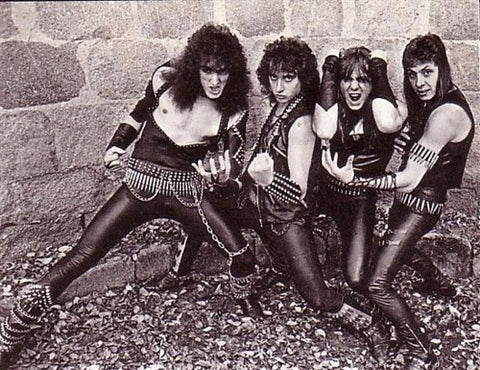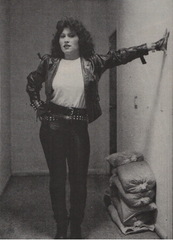South America, like in Brazil, Argentina, Chile, Ecuador, Colombia, Bolivia to name a few and other Spanish-speaking countries in the Western hemisphere like Spain had a flourishing underground of heavy metal that is oftentimes overlooked, especially when compared to some European countries. The metal beginnings of Spain took it’s reign starting in the early eighties, like most heavy metal bands. As an avid fan of foreign metal, along with having a Spanish-speaking mother I’ve always been intrigued by language. Since I never took the time to learn Spanish myself, opting to learn French instead, something I don’t fully regret, I just wish I could time travel and learn Spanish earlier so I would be able to understand the lyrics in some of these masterpieces. Over the past few days, I’ve been especially interested by the work coming out of Spain ever since stumbling upon a band called Santa. Though I had breezed past their seminal album, Reencarnación in the past, this was the first time I had re-visited it since along with the rest of the bands albums and was able to fully appreciate it. In conjunction with this re-discovery, someone had brought to my attention the existence of a Facebook group called “Spanish Metal Militia”, solely focusing on bands that surfaced in Spain during the eighties through photos, footage, and information curated by Spanish metal fanatic Pedro Ocete. I’ve found it to be the perfect resource for an introduction into this country’s musical landscape.
To compare the divisions between South American territories and European, countries like Brazil adapted to their signature “jungle metal” and cemented the roots for death metal, whereas Spain took a more melodic approach where we see more bands that are speed metal and traditional heavy metal oriented. This hints that there was strong borrowing from the already developed New Wave of British Heavy Metal bands. Many tried to replicate this sound but in doing so, created their own unique styles.
 The most prominent scene to arise would have to be the one that joined the likes of bands that have gone down the commercial route (but who very much so started on the same level of obscurity as the other bands that will be mentioned later on), the face of this movement being Angeles del Infierno. They achieved widescale success, while for the most part keeping true to their roots sonically. Opening for bands like Motorhead and Saxon helped boost their ranks. Obús and Barón Rojo can arguably be added into this categorization.A big trademark of Spanish metal would be the inclusion of the word ‘metal’ appearing every .5 seconds in the lyrics. But let’s be real, what’s a heavy metal band without this element? If you can look past the cheesiness of some of the lyrical themes, you’ve found yourself a musical goldmine.
The most prominent scene to arise would have to be the one that joined the likes of bands that have gone down the commercial route (but who very much so started on the same level of obscurity as the other bands that will be mentioned later on), the face of this movement being Angeles del Infierno. They achieved widescale success, while for the most part keeping true to their roots sonically. Opening for bands like Motorhead and Saxon helped boost their ranks. Obús and Barón Rojo can arguably be added into this categorization.A big trademark of Spanish metal would be the inclusion of the word ‘metal’ appearing every .5 seconds in the lyrics. But let’s be real, what’s a heavy metal band without this element? If you can look past the cheesiness of some of the lyrical themes, you’ve found yourself a musical goldmine.
Lesser known acts in terms of popularity or what I would call cult bands representing the more traditional heavy metal side and are more of my zone include Banzai, Excalibur, Tigres, EVO, Muro, and my personal favorite being Panzer. Of course there is a representation of thrash in bands like Legion and other more extreme bands, but they are more difficult to scope out as there was not a strong scene for that at the time in the particular area. Power metal and symphonic metal are perhaps the most widely produced subgenre of them all and to name them would be a burden in itself.

Spain is still home to churning out some badass metal. Bands like Leather Heart, Hitten, Lizzies, Sofire and Iron Curtain have helped preserve that raw and gritty eighties style of production and sound. Another component drawing me to Spanish metal would be the intensity of the crowd that appear at shows which I’ve seen through festival and concert footage. Much like other European audiences, I have noticed that Spanish headbangers are the first to go out and display the fanfare. Spain is home to some wonderful festivals that showcases these talents like Pounding Metal Fest, Leyendas del Rock, Rock Fest in Barcelona, and more. To prove just how “true” Spain is they have erected a statue in honor of ‘la abuela rockera’ or ‘the grandmother of rock’ seen on the cover of Panzer’s Toca Madera album. This woman on the cover was in fact a real metaller involved in the scene during the eighties. The video below shows that her heavy metal spirit is not a force to be reckoned with. At eighty-three years old this was a woman who never missed an AC/DC concert and was more real than a lot of people in the scene today.
That being said, the impact of Spanish metal is undeniable and the impact lingers on today. I leave you with some gems of the country to familiarize yourself with...
0 Comments:
Post a Comment